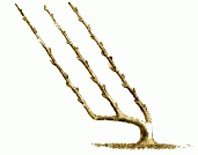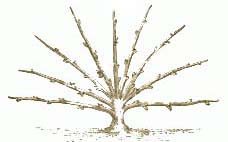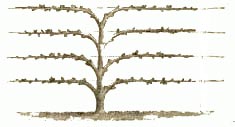Last updated April 2018
What ingredients could you grow and how?
Oats
Milk
Nuts
Fruit
Growing zones, pruning and other cultivation information for fruit and nuts
What ingredients could you grow?
-
-
- oats
- milk – really!
- nuts
- fruit – fresh or cooked
-
How do you grow the ingredients?
Well, you need land, time and energy to grow your own muesli, and cool storage space for the harvest, but even if you are not a smallholder, you can grow some of these ingredients in your garden or on your allotment, just for the challenge of growing your breakfast. While you’re waiting for your crops, you could always use an organic supplier/health food shop to fill the gaps.
Also, fortunately, crop failure for gardeners is not a disaster in the UK, as there’s always a supermarket or organic food shop online or close by to keep your pantry full. And, OK, growing the oats and milk may be more tricky than the fruit and nuts, but just to show you that it is possible, and fun to try…read on.
Oats (Avena sativa)
You can find small amounts of oat (Avena sativa) seed on sale since one of its common uses is greens for cats, hence its alternative names of cat grass or oat grass.
How much space do you need for a decent crop? Well, commercial yields work out at around 550g per square metre (1 lb per square yard) – but to obtain this, you’ll need to keep the sparrows off at sowing and ripening times, then harvest and thresh the oats (unless you choose the no-husk type), then crush them, so perhaps the shop option is the best.
Winter oat varieties produce a heavier summer crop than spring oat varieties (winter and spring refer to the sowing/growing time), but don’t sow a winter oat variety in spring as it needs a cold period to trigger flowering.
Sow winter oats in September (later in mild or sheltered areas) at around 300 seeds per square metre, and use a new patch of soil each year.
Harvest in July/August – if you are too late all the seed will be shed onto the ground for the birds and mice, so keep an eye out!
Milk
In medieval times, almond milk was a substitute for animal milk, which could not be stored, so had to be quickly converted to butter or cheese. Almond milk could be produced as required too, unlike animal milk, which is a more long-term undertaking, as you need a female sheep/goat/cow/nak/buffalo/horse or whatever to produce its young first before you can obtain (steal?) the milk.
For the ultimate in self sufficiency from a small plot, and for vegans, you could make almond milk yourself. We haven’t tried this ourselves yet, but this is what we were told at a medieval re-enactment event a while ago. Just take any volume of sweet almonds (take care; do NOT use bitter almonds, which are from a different plant and very poisonous), grind them, add twice their volume of water (boiling), leave 5-10 minutes, sieve out the bits, or use a blender to mix it all well together. Medieval recipes give the details. Additionally, the Almond Board of California gives a recipe using blanched almonds, roasting them for extra flavour and while warm, adding four times their volume of water, plus some vanilla or honey flavouring, and leaving this in the fridge for a day before blending and sieving.
To grow your own almonds, choose a sweet almond variety (Prunus dulcis dulcis). Be absolutely sure you do NOT grow the (poisonous) bitter almond (Prunus amygdalus amara), so check those Latin names carefully. Almonds are frequently grown as ornamental flowering trees because they do not crop well in all areas (they are hardy in zones 8-10 but early blossoms can be killed), so some sellers may not distinguish between the two types. Be sure to buy from a knowledgeable nursery and seek their advice on the likelihood of it cropping in your area.
Almonds should bear nuts on three to four-year old trees. To harvest, spread a net below the tree and tap the branches, or wait until the nuts fall naturally (early October in southern England, a week or so later elsewhere). The husks will be split if fallen naturally, so remove these and dry the nuts in a well ventilated place, in sunshine or an airing cupboard. If squirrels are in your area, then harvest earlier, and start off by drying the complete nut until you can split off the husk and then continue to dry the nut.
Nuts
Apart from almonds for nuts and milk, there are hazelnuts and walnuts that you could grow, plus sweet chestnut if your garden or plot is big enough for such a tree. Expect to wait around four years for your first crop.
Hazel (Corylus avellana) is hardy in zones 6-9 and can grow to a large tree, so prune to keep it within bounds. Grow filberts, cobnuts or hazel nuts as an open centred bush (imagine a wine glass with the branches around the bowl). There are many hazels cultivated for ornamental purposes – check that these will also produce a decent crop.
Walnut (Juglans regia) is hardy in zones 5-8. It can become a very big tree, so choose an early maturing/fruiting (often described as precocious) type and prune carefully.
Sweet chestnut (Castanea sativa) – choose marron types for their nuts – can be too big for most gardens, so again, choose and prune carefully. Sweet chestnut likes sandy, well drained soil and is hardy in zones 5-9.
Fruit
Add fruit – fresh or stewed – there are so many different types to grow. Growers usually divide fruit (and nuts) into two categories – top fruit borne on trees, and soft fruit borne on canes or bushes.
Tree (or top) fruit
Apples (Malus domesticus) – grow in most of the UK. A selection of dessert apples are available from Thompson and Morgan.
Pears (Pyrus communis) – Manchester is probably the northern limit. A selection are sold by Thompson and Morgan.
Asian pear – looks like an apple, tastes like a pear, and may grow where you cannot grow other pears. Sold by a few specialist nurseries including Chrs Bower’s.
Figs (from Thompson and Morgan) require little work. Hardy in zones 9-10; half-hardy in zone 8 and needs lots of sun to ripen in this zone.
Black mulberries (Morus nigra) are slow to fruit (at least 6 years) but worth the wait. Hardy in zones 5-8.
Stone fruit:
Plums (Prunus domestica) and (green) gages. Hardy in zones 4-8.
Damson (hardier than plums) and bullace for culinary use are less vigorous so better for smaller spaces. Damsons are hardy in zones 4-8; bullaces zones 3-8.
Apricots (Prunus armeniaca)
Peaches (Prunus persica) – hardy in zones zones 8-10.
Nectarines (Prunus persica var. nectarina) – hardy in zones 9-10.
Sweet cherries (Prunus avium) – you’ll have to keep the birds off these! Hardy in zones zones 9-10.
Soft fruit
Less expensive than top fruit, producing crops sooner, and taking up less space, so ideal for smaller gardens.
Dessert gooseberries (very sweet, and often red). We have Whinham’s Industry but it has very stiff hairs, so we still cook it before eating it, although there’s no need for sugar. Other red desserts are Captivator (almost thornless, which is an advantage) and Xenia.
Strawberries – for a succession of fruit from May to July, grow different varieties that fruit at early, mid and late season. You could also grow perpetual (also called remontant or ever-bearing) types, which crop June-Oct (if protected from frost) – these are best grown annually from plants or seed as the yield can drop off in their second year.
Raspberries – choose a mix of summer and autumn-fruiting raspberries for a long cropping season.
Blackberries (Rubus fruticosus) and various crosses (Jostaberry, Hildaberry,Tayberry, Boysenberry).
Blueberries (Vaccinium corymbosum), available from Thompson & Morgan take about 6 years to produce a good crop, and two or more shrubs increase pollination. Hardy in zones 4-7. These acid-loving plants need lime-free soil or potting compost, and benefit from acid plant fertiliser.
Currants (black , red , white – birds ignore white ones)
Dessert grapes – outdoor types are hardy in zones 9-10 and sheltered spots in zone 8. More choice of varieties if you have an unheated or heated greenhouse.
Kiwi fruit (Actinidia deliciosa) – the more recent marketing name for Chinese gooseberries. Plants are male or female, so be sure to grow at least one male with your female fruiting plants. Hardy to zone 8.
Grow your own breakfast muesli – fruit and nut growing information
General notes
Where in the UK? Zones and other info.
USA climate zones are often quoted by authors and suppliers when referring to hardiness, and these can be applied to the UK too:
Zone 9: the mild coastal areas of the island of Ireland, and the coastal areas of western Scotland, Wales and the English south-west.
Zone 8: colder than 9 – the majority of the UK.
Zone 6: the coldest in the UK – the high land of the Cairngorms, Scotland.
Use these zones as a very general guide when choosing what to grow, and if your area is borderline for the plant you want to grow, be sure to position it in a sheltered sunny site, preferably against a wall that will act as a storage heater.
Choose varieties that are hardy in your area. However, remember that ‘hardy’ refers to the plant itself surviving a cold winter, not the blossom. But of course the flower buds and blossom have to survive undamaged to produce a crop. So look for varieties that flower after the risk of frosts has passed in your area, or be ready to protect your plants either with fleece, netting, or by spraying water if you can be sure it will freeze (this may sound daft, but it protects the blossom and is used commercially).
You also have to take into account local conditions, height above sea level, local wind strengths and direction, frost pockets, waterlogging and soil type. Be guided by what is already growing successfully in your area, and ask neighbours for their experiences of plants that do not do well. Before buying expensive plants, consult the supplier too for advice.
Site and soil
A sunny site is necessary for ripening most fruit and nut crops. It’s not just for colour but flavour, although some fruits (some dessert apples, some dessert pears, quince, medlar) continue to mature in store and in fact are best not eaten fresh off the tree.
Also, to grow well, fruit and nut plants need soil that retains moisture but not in a site prone to waterlogging.
Pollination
Another essential is encouraging insect pollinators, so grow your plants in a place sheltered from high winds which would deter the bees and other insects. However, be careful that it’s not such a sheltered place that it is a frost pocket. You often need more than one nut or fruit tree to be sure of pollination – even if you choose a self-fertile type – seek the advice of the supplier. And for flowers that appear too early for the insects, or for plants grown in greenhouses,you will have to hand-pollinate the flowers by shaking the plants or using a small brush or cotton bud.
You may need more than one plant to ensure cross-pollination and a crop, so this is one more thing to check with your supplier.
Some nut trees (hazel, sweet chestnut, walnut) are wind-pollinated, so are less of a problem, but just because they are wind-pollinated, that doesn’t mean they will grow well in a windy spot.
Restrict growth/prune
For easy management (hand-pollinating, pruning, draping with fleece and harvesting), choose trees grafted on dwarfing rootstocks (for smaller plants and earlier maturity) and prune to create a bush or vase/wine glass shape, or train as cordons, step-overs (which are just horizontal cordons), fans or espaliers to keep them compact.

A bush (above) has a very short ‘leg’ ie main trunk or stem.

A vase or wine glass shape (above) has an open centre.

A stepover (above) is really two horizontal cordons.

You can train main stems at an angle (see above) against wire supports.
An espalier (above) is trained along horizontal wires.

A fan (above) is also trained on canes supported by horizontal wires.
These drawings come from The Illustrated Dictionary of Gardening, edited by George Nicholson of Kew Gardens. Much of this Victorian encyclopaedia is just as relevant today. We have Alec’s great-grandfather’s set (he was a nurseryman) but you can see all the pages online as they’ve been scanned by the Biodiversity Heritage Library.
Protect the crop
Back to the present, be sure of keeping the crop for yourself, so use a fruit cage if you can to keep out birds, check for pest and disease symptoms and store your harvest in a cool dry vermin-proof place.
Nuts and fruit – detailed information
Suppliers can usually provide growing guides and information on ultimate (if unpruned) sizes of specific plants that they sell.


